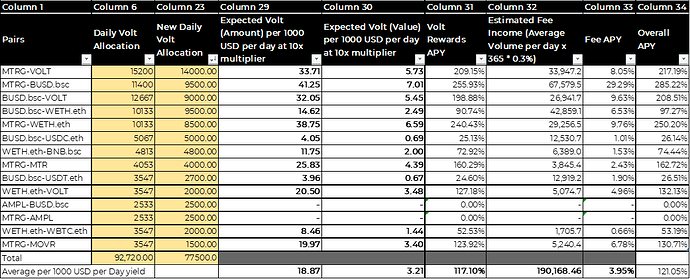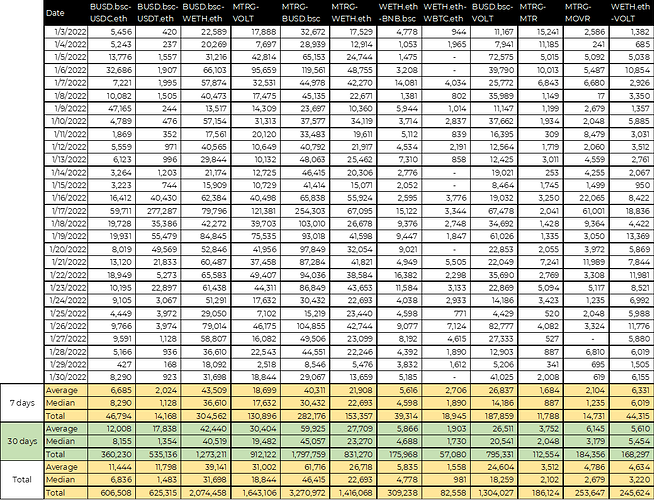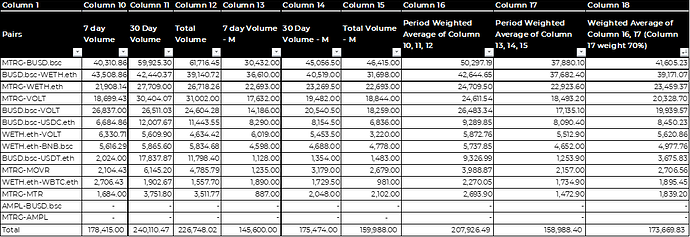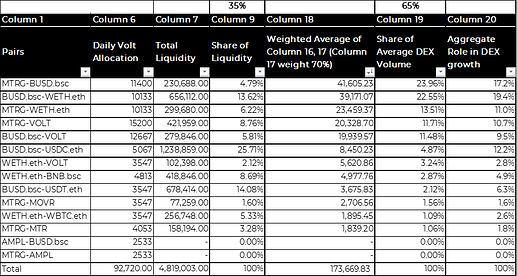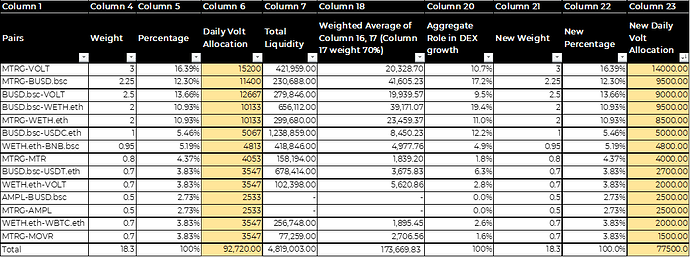Hello Meterians,
The Third Incentive cycle on Meter Mainnet started on January 7, 2022. It will end on February 5, 2022.
As the third cycle comes to an end, we will review the performance of the incentivized pairs and determine the reallocation of volt for the fourth cycle from February 6, 2022 to March 7, 2022.
TL,DR;
Evaluation of Incentivized Liquidity Pairs:
We could define a few of the critical parameters that will help us evaluate the performance of the liquidity pairs on Voltswap;
- Transaction Volume
- This is by far the most important parameter for evaluation since the goal of the product is to generate free cash flows from the operations and be self-sustainable
- Transaction volume is also largely dependent on market conditions and token specific events, to smoothen the effect of these variations, we have considered both Median as well as Average volume
- Total Value Locked (TVL)
- This is a critical parameter to gauge the adoption of the DEX. Higher TVL is typically correlated with higher adoption and enables bigger buys on the DEX without too high a price impact
- Turnover of the pair
- It can be defined as the ratio of Volume by TVL
- Higher volume for a specific TVL means that the pair has a higher utilization of assets and the LPs are generating higher revenues due to the turnover.
Evaluation Parameters;
- The overall role of a pair is a factor of both the TVL it adds to the Voltswap as well as the transaction volume of the pair.
- However, the intent of TVL is to primarily aid transactions and lower slippages, we will try to weigh transaction volume at 65% and TVL at 35% to gauge an overall role of a pair in the growth of the ecosystem
- We will also try to look at the turnover (average Volume by TVL) to determine the capital efficiency of the pairs
Based on the above parameter, lets us look at the statistics on Meter Mainnet
- Current Volt allocation to the Incentivized Pairs
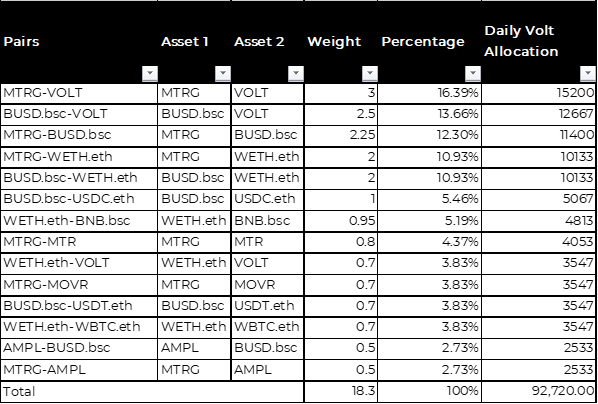
- Daily transaction volume of Incentivized Pairs
- Liquidity for Incentivized Pairs
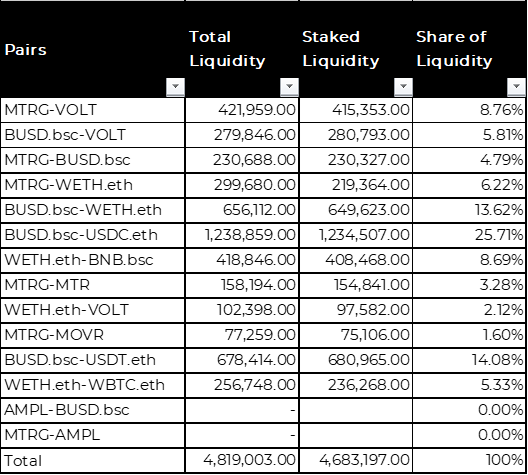
- Transaction Volumes for Incentivized Pairs – Since transaction volumes do depend on market conditions and token specific events, a smoothening effect is applied to add higher weights to immediate past
Column 10,11,12 are average volumes
Column 13,14,15 are median volumes
Column 18 is the overall average volume of each pair since the second cycle smoothened for periods (7-day, 30-day, Total Volume) and method (average volume and median volume). Pure Average volume would have the bias of outlier days where there is very high transaction volume or very low transaction volume
- Evaluation of Pairs based on overall role in DEX Growth (65% weight to transaction volume and 35% weight to TVL)
Insights
- MTRG-BUSD has the most volume per TVL of all the pairs. We can target to improve more liquidity on the pair to enable lower slippage.
- BUSD.bsc-USDC.eth and BUSD.bsc-USDT.eth have both high liquidity but very low transaction volumes.
- Top 5 incentivized pairs have 83% of transaction volume while holding 40% liquidity
- BUSD.bsc-VOLT liquidity has been stagnant for almost 2 months even though the highest rewards are allocated to the pair
- MTRG-MOVR and WETH.eth-WBTC.eth have really low transaction volumes
- Turnover (Volume by TVL) for Incentivized Pairs
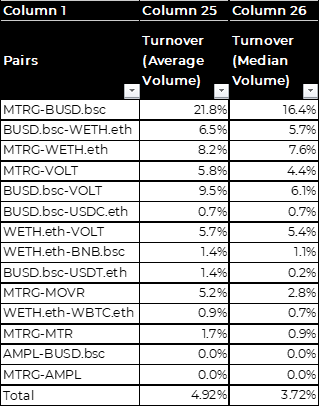
The turnover data presents another perspective on the insights presented earlier. Stable coin pairs and WBTC.eth-WETH.eth have very low turnovers. MTRG-BUSD.bsc has had the best turnover across all the cycles. Increased liquidity in the pool could help reduce the price impact for the users.
- Volt Earnings per 1000 USD of Liquidity provided
Insights
- MTRG-BUSD.bsc, MTRG-WETH.eth have been allocated higher rewards to attract liquidity. As anticipated, they have the highest turnovers but the liquidity has not increased despite very high APY
- The lowest return is on BUSD.bsc-USDC.eth at around 25% annually. This is expected since the pair does not have any impermanent loss
Based on the above insights, the volt allocation proposed for the fourth cycle on Meter Mainnet are as below;
The Volt Earnings per 1000 USD of Liquidity provided based on new Volt allocation is as below;
Insights:
- MTRG-BUSD.bsc and MTRG-WETH.eth have been proposed as the highest APYs to increase liquidity in these pools. They have the highest turnovers.
- Assessing that BUSD.bsc-VOLT has not received traction yet, the volt emission is further reduced. Even so, the pair still has high APY. We expected users to provide more liquidity and deepen the pool further.
- BUSD.bsc-USDC.eth has the lowest volt earnings. This is due to 2 reasons – Lower transaction volumes and no impermanent loss
- WETH.eth-VOLT, BUSD.bsc-USDC.eth, and BUSD.bsc-USDT.eth allocations are reduced due to much lower transaction volumes. The volt earnings are still equivalent to average earnings.
- Allocation has been maintained for the MTRG-MTR pair at 4000 Volt/day as we look to deepen the MTR liquidity on Voltswap.
- The estimated earnings are at Volt price of $0.17 USD and Voltswap valuation of $2.7 million USD. The earning potential significantly increases with increased Volt price.
Higher liquidity provision for Volt pools is the key reinforcement driver that will enable increased volt price as well as lower price impacts for users.
The aggregate estimated APY of Voltswap is 117.10% from Volt Rewards and 3.95% from transaction fees totaling 121.05%.
